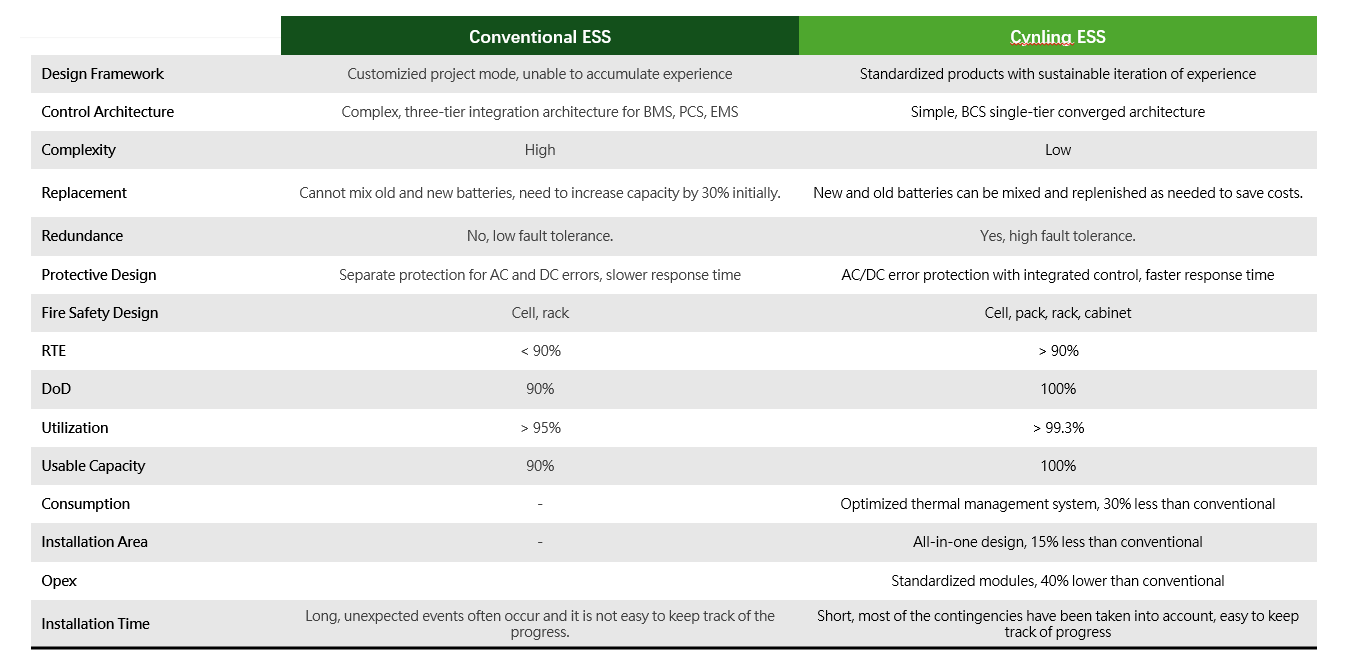Development History of Energy Storage Systems
Through highly integrated design, batteries are managed in a refined manner to improve the safety and economy of energy storage equipment.




Cynling’s Third-Generation All-in-one BESS
One cluster one management, no parallel design

Long life battery
Integrates long life, high performance, high quality CATL LFP battery cells, cycle times ≥ 8000 times
Efficient and balanced BPS
Adopt bidirectional high-efficiency balancing technology to reduce series loss
High-performance multifunctional PCS
Level topology, maximum efficiency up to 99.3%, integrated BMS and power distribution functions
Liquid Cooling System
Integrated high-efficiency liquid cooling system, temperature difference ≤ 3°C
Fire safety system
The energy storage cabinet adopts fire-resistant insulation materials and Pack-level immersion fire protection system
Security brought by the deep integration of software and hardware technologies
Two more Layers
Much more Safer
Four-Layers of Fire Protection
Safety Design Improvement
Third-Generation All-in-one BESS
Cell
The system features Single-Cell Thermal Management, Cell-Level Monitoring and Analytics AI,AIand Preventive Alerts to ensure optimal performance and safety.
Pack
The independent fire detection device precisely locates runaway cells and targets failed modules by injecting perfluorohexane for rapid fire suppression and recovery.
Rack
The system monitors temperature, gas, and smoke levels, and employs aerosol fire suppression for comprehensive safety management.
Cabinet
The storage cabinet features compartmentalized isolation to prevent fire spread and includes a water-cooling system for up to 1.5 hours of fire resistance.
FLAT
Architecture
Novel Safety Control Architecture
Safety Design Innovation
Third-Generation All-in-one BESS
Novel Architecture
Our proprietary, newly developed FLAT control architecture integrates data from individual cells to the entire microgrid in real-time, enabling seamless battery management, power control, and microgrid management while effectively eliminating system control and protection blind spots.
Communication Safety
The enhanced communication architecture and control software design integrate the Battery Management System (BMS) and Power Conversion System (PCS) into a unified Battery Power System (BPS), effectively eliminating the risk of uncontrolled operations due to module disconnection.
AC/DC Fault Protection
The system provides comprehensive AC/DC fault protection by continuously monitoring real-time data from both AC and DC sides, combining physical models with control algorithms to implement a mutual protection mechanism that proactively detects potential anomalies and safeguards the system.
Rapid Response
The FLAT control architecture achieves millisecond-level data transmission, computation, and response, enabling rapid protective actions.
Innovative technology, higher returns
Next Generation
Higher Utilizatio
One Cluster, one PCS
Maximize Lifetime BESS ROI
Third-Generation All-in-one BESS
System Efficiency >90%
BPS adopts bi-directional high-efficiency equalization technology to reduce cascade loss; PCS uses multi-level topology to achieve maximum efficiency of 99.3%.
100% DoD
The system features a 100% charging and discharging depth with a non-parallel design, where the PCS module converges high voltage AC, avoiding inter-cluster loop current and eliminating the short board effect of the battery cell.
Lower Opex
The system achieves lower operating costs by supporting the mixed use of new and old battery packs, allowing for on-demand expansion without overprovisioning. Its redundant design reduces downtime risk, ensuring a system availability rate of over 99.9%, while also decreasing auxiliary power consumption by 30%.
Iterative Design
The system employs an iterative design approach, deeply applying standardized, non-custom engineering product design principles to address potential risks and ensure optimal product performance throughout its entire lifecycle.
Cynling ESS vs. Conventional ESS

Power capacity
125kW / 250kWh
Conversion efficiency
≥ 90% under standard conditions
AC output
400Vac ± 15%, 50/60 Hz
DoD
100%
Cycle
≥ 10,000 times
Protection level
IP54
Thermal Management System
Battery (liquid cooling) + PCS (air cooling)
Occupied area
1.4 m2
Dimensions (W x D x H)
1,000 x 1,300 x 2,350 mm
Energy density
178.6 kWh/m2
Certification (obtaining)
IEC 62477, IEC 61000, IEC 62619,
IEC 60730, UN38.3, CNS 62619
IEC 60730, UN38.3, CNS 62619
Grid Connection Standard (in progress)
IEEE 1547, EN 50549-2,
VDE 4105, UTE C15-712-1, CEI 0-21
VDE 4105, UTE C15-712-1, CEI 0-21

Power capacity
209kW / 418kWh
Conversion efficiency
≥ 90% under standard conditions
AC output
690Vac ± 15%, 50/60 Hz
DoD
100%
Cycle
≥ 7,000 times
Protection level
IP55
Thermal Management System
Battery (liquid cooling) + PCS (air cooling)
Occupied area
1.82 m2
Dimensions (W x D x H)
1,400 x 1,300 x 2,350 mm
Energy density
229.7 kWh/m2
Certification (obtaining)
IEC 62477, IEC 61000, IEC 62619,
IEC 60730, UN38.3, CNS 62619
IEC 60730, UN38.3, CNS 62619
Grid Connection Standard (in progress)
IEEE 1547, EN 50549-2,
VDE 4105, UTE C15-712-1, CEI 0-21
VDE 4105, UTE C15-712-1, CEI 0-21






